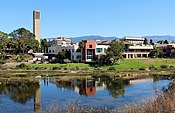
A wetland is a distinct semi-aquatic ecosystem whose groundcovers are flooded or saturated in water, either permanently, for years or decades, or only seasonally. Flooding results in oxygen-poor (anoxic) processes taking place, especially in the soils. Wetlands form a transitional zone between waterbodies and dry lands, and are different from other terrestrial or aquatic ecosystems due to their vegetation's roots having adapted to oxygen-poor waterlogged soils. They are considered among the most biologically diverse of all ecosystems, serving as habitats to a wide range of aquatic and semi-aquatic plants and animals, with often improved water quality due to plant removal of excess nutrients such as nitrates and phosphorus.
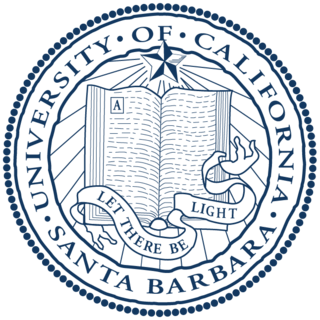
The University of California, Santa Barbara is a public land-grant research university in Santa Barbara County, California, United States. Tracing its roots back to 1891 as an independent teachers' college, UCSB joined the University of California system in 1944. It is the third-oldest undergraduate campus in the system, after UC Berkeley and UCLA.

Katherine Esau was a pioneering German-American botanist who studied plant anatomy and the effects of viruses. Her books Plant Anatomy and Anatomy of Seed Plants are key texts. In 1989, Esau received the National Medal of Science "In recognition of her distinguished service to the American community of plant biologists, and for the excellence of her pioneering research, both basic and applied, on plant structure and development, which has spanned more than six decades; for her superlative performance as an educator, in the classroom and through her books; for the encouragement and inspiration she has given to a legion of young, aspiring plant biologists; and for providing a special role model for women in science." When Katherine Esau died in year 1997. Peter Raven 'Director of Anatomy and Morphology' of 'Missouri Botanical Garden' remembered that she absolutely dominated the field of plant Biology even at the age of 99.
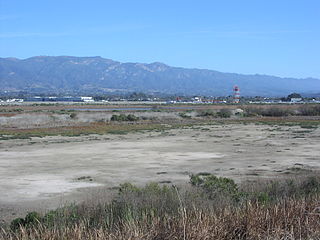
The Goleta Slough is an area of estuary, tidal creeks, tidal marsh, and wetlands near Goleta, California, United States. It primarily consists of the filled and unfilled remnants of the historic inner Goleta Bay about 8 miles (13 km) west of Santa Barbara. The slough empties into the Pacific Ocean through an intermittently closed mouth at Goleta Beach County Park just east of the UCSB campus and Isla Vista. The slough drains the Goleta Valley and watershed, and receives the water of all of the major creeks in the Goleta area including the southern face of the Santa Ynez Mountains.

The Golden Gate Biosphere Network is a voluntary coalition of federal, state and local government agencies, nonprofit organizations, universities, and private partners within the Golden Gate Biosphere region. The Network aims to protect the region's biodiversity and conserve its natural resources. The Network has been part of the UNESCO Man and Biosphere Programme since 1988.GGBN is also part of the US Biosphere Network as well as EuroMAB. It is recognized by UNESCO for its "significance for biological diversity conversation" and organizational efforts involving municipal authorities and private interests.
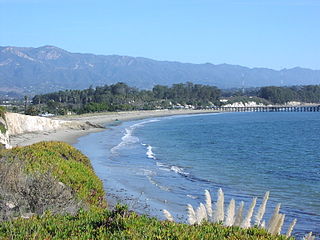
Goleta Beach is a region of coastline located near Goleta, California, just east of the University of California, Santa Barbara (UCSB) campus. A portion of the shore of Goleta Bay is managed by the County of Santa Barbara, as the Goleta Beach County Park (GBCP). The beach itself is partly man-made as sand was spread onto an existing sandspit in 1945. The beach is a seasonal habitat for migrating shorebirds, including the snowy plover, an endangered species, and is occasionally closed due to nourishment efforts.
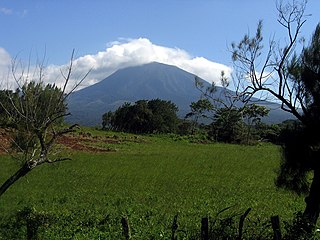
Guanacaste Conservation Area is an administrative area which is managed by the Sistema Nacional de Areas de Conservacion (SINAC) of Costa Rica for conservation in the northwestern part of Costa Rica. It contains three national parks, as well as wildlife refuges and other nature reserves. The area contains the Area de Conservación Guanacaste World Heritage Site, which comprises four areas.
Cornelius Herman ("Neil") Muller, born Müller, was an American botanist and ecologist who pioneered the study of allelopathy and oak classification.

The Coastal Science Campus of the University of California, Santa Cruz consists of five main institutions: UC Santa Cruz's Long Marine Laboratory, UC Santa Cruz's Coastal Biology Building, the NOAA Southwest Fisheries Science Center, the Seymour Marine Discovery Center, and the California Marine Wildlife Veterinary Care and Research Center.

Lupinus bicolor is a species of lupine known as the miniature lupine, Lindley's annual lupine, pigmy-leaved lupine, or bicolor lupine.
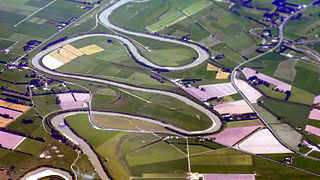
Floodplain restoration is the process of fully or partially restoring a river's floodplain to its original conditions before having been affected by the construction of levees (dikes) and the draining of wetlands and marshes.

Wetland conservation is aimed at protecting and preserving areas of land including marshes, swamps, bogs, and fens that are covered by water seasonally or permanently due to a variety of threats from both natural and anthropogenic hazards. Some examples of these hazards include habitat loss, pollution, and invasive species. Wetland vary widely in their salinity levels, climate zones, and surrounding geography and play a crucial role in maintaining biodiversity, ecosystem services, and support human communities. Wetlands cover at least six percent of the Earth and have become a focal issue for conservation due to the ecosystem services they provide. More than three billion people, around half the world's population, obtain their basic water needs from inland freshwater wetlands. They provide essential habitats for fish and various wildlife species, playing a vital role in purifying polluted waters and mitigating the damaging effects of floods and storms. Furthermore, they offer a diverse range of recreational activities, including fishing, hunting, photography, and wildlife observation.
Irene Moon is an American entomologist, performance artist, musician, playwright, actor, and filmmaker. She has published in the field of entomology as Katja Seltmann, and is the current director of the Cheadle Center for Biodiversity and Ecological Restoration at the University of California, Santa Barbara.
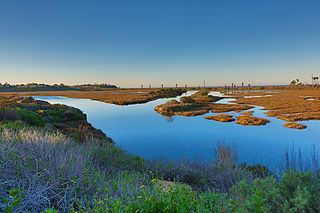
San Elijo Lagoon Ecological Reserve is one of the largest remaining coastal wetlands in San Diego County, California, United States.
Vernon Irvin Cheadle was an American botanist, educator and university administrator. He served as the second chancellor of the University of California, Santa Barbara (UCSB) from 1962 to 1977.

Mangrove restoration is the regeneration of mangrove forest ecosystems in areas where they have previously existed. Restoration can be defined as "the process of assisting the recovery of an ecosystem that has been degraded, damaged, or destroyed." Mangroves can be found throughout coastal wetlands of tropical and subtropical environments. Mangroves provide essential ecosystem services such as water filtration, aquatic nurseries, medicinal materials, food, and lumber. Additionally, mangroves play a vital role in climate change mitigation through carbon sequestration and protection from coastal erosion, sea level rise, and storm surges. Mangrove habitat is declining due to human activities such as clearing land for industry and climate change. Mangrove restoration is critical as mangrove habitat continues to rapidly decline. Different methods have been used to restore mangrove habitat, such as looking at historical topography, or mass seed dispersal. Fostering the long-term success of mangrove restoration is attainable by involving local communities through stakeholder engagement.
The University of California, Santa Barbara (UCSB) traces its roots back to the 19th century when it emerged from the Santa Barbara School District, which was formed in 1866 and celebrated its 145th anniversary in 2011. UCSB's earliest predecessor was the Anna S. C. Blake Manual Training School, named after Anna S. C. Blake, a sloyd-school which was established in 1891. From there, the school underwent several transformations, most notably its takeover by the University of California system in 1944.
Joy Buswell Zedler is an American ecologist and professor of botany at the University of Wisconsin–Madison (UW), holding the title of Aldo Leopold Chair of Restoration Ecology. In addition to restoration ecology, she specializes in the ecology of wetlands, rare species, interactions between native and introduced species, and adaptive management.
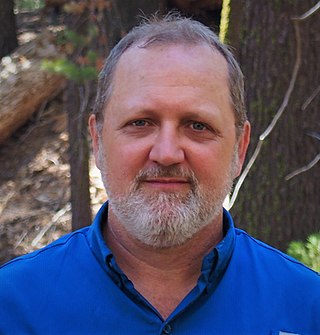
Bradley Cardinale is an American ecologist, conservation biologist, academic and researcher. He is Head of the Department of Ecosystem Science and Management and Penn State University.

North Campus Open Space (NCOS) is a 136-acre wetland and upland restoration project (55 ha) in Goleta, California. Managed by the Cheadle Center for Biodiversity and Ecological Restoration (CCBER), a research center under the Office of Research at the University of California, Santa Barbara (UCSB), the property had been previously developed into a golf course. The project included the restoration of the historic upper half of Devereux Slough and adjacent upland and wetland habitats that support important local native plant and animal species, reducing flood risk, providing a buffer against predicted sea level rise, and contributing to carbon sequestration while also supporting public access and outreach, and facilitating research and educational opportunities.




















